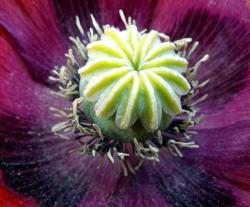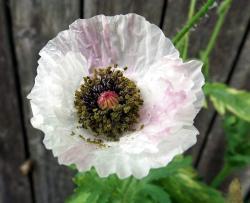Poppies like cool spring weather and relatively dry conditions. They prefer to be sown in-place (no transplanting) because even the smallest disturbance to their tap root can cause trouble. In warm-spring areas, such as Kentucky (where the author lived for many years), growing them can be difficult for many reasons.
First of all, springtime temperatures can easily reach the 70s and 80s by March, even if only for brief periods. These temperatures will cause young poppy plants to wilt as they need extended periods of cool, relatively dry weather for most of their growing season (they can tolerate more warmth and humidity at the tail end of their flowering season).
Second, excessive rain will damage young plants not only by causing them to rot (like most other plants), but also by dislocating the long, delicate taproot. If a single raindrop falls "just right" onto a young poppy seedling, it can effectively dislodge the root and cause the plant to wilt, turn yellow, and die over the course of a few days. When this happens the new poppy grower may not even "connect the dots" to the massive die off from the rain a few days earlier. Rain also has the effect of completely burying the newly-planted tiny poppy seeds before they even sprout, or (worse) washing them away entirely. This author has experienced both.
Third, in warm-spring areas, by the time poppies bloom in late May and early June, other annuals such as marigolds and zinnias not only quickly "fill in" the area where poppies are growing, they also will often out-compete the poppies entirely, leading to many fewer poppy blooms at the expense of the faster-growing warm-season annuals.
The solution to all of these problems is to sow your poppies in containers, at least twice, early in the year, AND to protect against high temperatures and too much rain. Trial-and-error has taught the author how to do just those things. It seems complicated at first, but after one growing season it becomes second nature, and the reward -- fancy, lush, delicate, blooms -- is worth it.
First, get the correct-sized pot. Anything about 18" or wider will work for several plants, depending on the varieties you are growing. It is advantageous to drill or melt additional drainage holes and to sit the pot on bricks or other "feet," such as pieces of 2"x4"s, so that there is no doubt that the container is draining well.
Next, the soil is important, needing to drain well, BUT it does not have to be especially "rich" or "nutrient dense." Poppies do well in relatively poor soil, where they produce more flowers and fewer leaves.
Then, sow the poppies at least twice. Depending on how "warm" your "warm spring" area is, you might sow them in December and February or in February and March. In central Kentucky, Saint Valentine's Day and Saint Patrick's Day were always good benchmarks. A week sooner or a week later is OK. How you sow is also very important. Poppies do not like to be buried. They are tiny, and scattering them always ends up in uneven distribution. Plus, when they are scattered, they are more easily washed away or watered too heavily. A neat trick to use is ice trays. Yes, ice trays! Fill an ice tray half-full with water, freeze it, then sow the seeds on top of the frozen ice and cover with water again, to re-freeze. The seeds can be kept in your freezer this way for several days by experience, but possibly a lot longer.
Once you are ready to sow your ice cubes, you can simply sit the cubes in a row on top of the soil in the pot. That's it. The frozen water will not hurt the poppies at all. In fact, there are some schools of thought that say it actually helps them by mimicking a later winter thaw.
You may now water your seeds/ice lightly, but if you choose to water, the author prefers to water the pot BEFORE sowing the ice cubes. This is an example of the type of ice cube trays favored by the author:

These are called "mini ice cube trays" or similar and are available at fancy retail stores in the US, but these were found at a thrift store. Any regular-sized ice cube tray would work as well.
Next, depending on the area you call home, you might have to provide protection from too much rain. In Kentucky even relatively "dry" springs were too wet for young poppies. There are several ways to provide protection from the rain while also providing enough sunlight. The easiest, in the author's experience, is to use a clear shower curtain raised several inches over the pots. One way to accomplish this is to put stakes into the ground and then tape, glue, or otherwise fasten the shower curtain several inches above the top of the plants. You want to allow maximum sunlight and airflow, but minimum rain. IMPORTANT: this step means that you will be responsible for watering your poppies. It is perhaps the most time-consuming aspect of growing poppies this way, but in areas with very warm and wet springs there are not a lot of alternatives.
Here is a brief sketch to show how the author arranged things when living in such an area:

If you want, you can also fashion a plastic greenhouse or even use sheets of acrylic/plexiglass. Just make sure there is adequate ventilation.
Lastly, when you do water your poppies, especially if the temperature is expected to rise that day, use cool or cold water. On days that were forecast to reach into the 80s, this author would use a bag of ice to water his plants. Literally just spread the ice chips around the base of the plant like mulch. This helps to water the plant slowly and helps to keep it cool.
Some final tips for growing poppies in areas with warm springs:
Don't be afraid to experiment with timing. You may benefit from sowing in December, whereas a gardener 10 miles away might benefit from February sowing. That's why it's important to sow at least twice. The seeds may sit on top of the soil for several weeks before they sprout. This is normal.
Once flower buds start to appear, you usually can remove whatever barrier you've used to keep them from being drowned. If you remove it before then, the author has found that some plants are still prone to over-soaking and dying. This obviously will vary based on where exactly you live and how much rain you are getting.
Also, don't forget that breadseed poppies have edible pods. You can move the pots to an out-of-the-way area after blooms are done in order to wait for the pods to form fully, or you can just chuck the whole thing into the compost bin.
Lastly, here are some examples of poppies grown in zone 7A in Kentucky, all grown in pots from ice cubes and with ice watering into the early summer months, with springtime temperatures in the upper 80s and low 90s:






| Thread Title | Last Reply | Replies |
|---|---|---|
| location for grow by raven0005 | May 8, 2018 6:08 PM | 0 |
| Ice Cube Poppies by mcintyrelin | Jun 10, 2017 9:34 AM | 0 |
| Ice Cube Poppies by lisa100467 | Jun 7, 2017 9:00 PM | 1 |
| Thanks for the intriging article. by pod | Jun 7, 2017 8:33 AM | 3 |